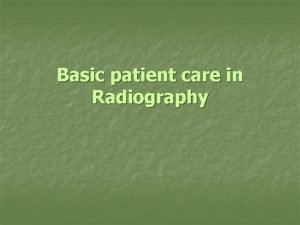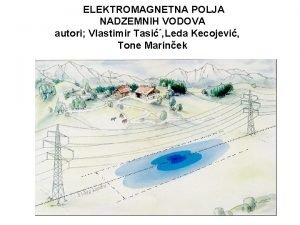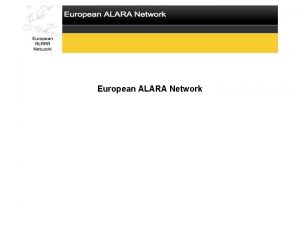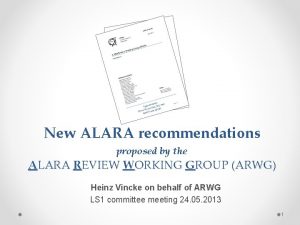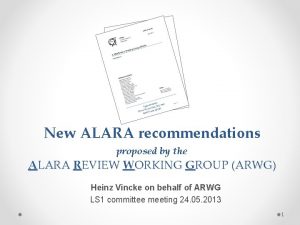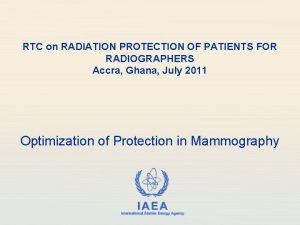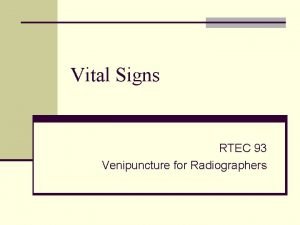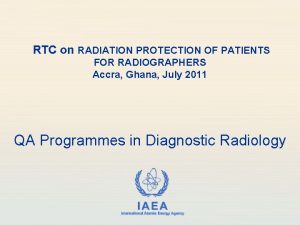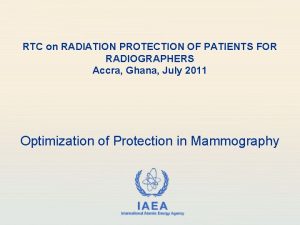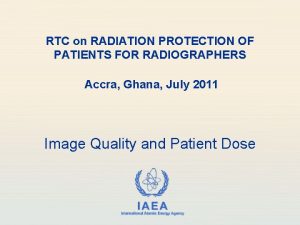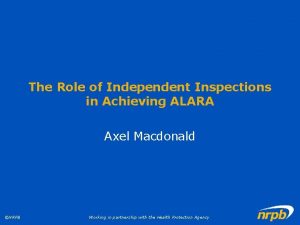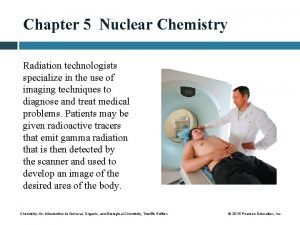The role of Radiological technologists Radiographers in ALARA



























- Slides: 27

The role of Radiological technologists/ Radiographers in ALARA implementation and the influence of MED 97/43 on that. Dimitris Katsifarakis Radiological Technologist ISRRT /ECRRT representative 10 th EAN workshop Prague, Sept/2006

The reason for the survey l l l The questionnaire was intended to focus on the status of the directive in the countries and how it was (or will be) implemented and how that has (or will) effect the position of the Radiographer as a health care professional.

Method l l Α simple questionnaire with limited number of questions , to keep it simple and to the point. Of course this limited the amount of information that could be gathered.

Response l l l l The Questionnaire e-mailed in August 2002, to 27 council members in Europe, of which 15 were EU countries and 12 were non-EU ountries. 9 of the non-EU countries join the EU in 2004 or soon after that the response was from 14 EU countries and 6 non-EU member countries (74% response).

Transposition of the MED l Has the European Directive MED/97/43/Euratom been transposed into your national legislation? The MED has not been implemented (2002) into the legislation of 2 EU countries (France - only in parts and is underway in Ireland). No answers came from Italy. In Iceland Norway the Radiation Protection legislation has been changed recently and adapted to the MED.

Radiographer’s role Is the radiographer’s role, as the person entitled to carry out a radiological examination/treatment under the authority of a radiologist/ oncologist, recognized in your national legislation?

Radiographer’s role: If YES, is their role in radiation protection recognized by the legislation? l l Through legislation in almost all the countries (16 = 84%) the profession of radiographers (diagnostic area) is recognized for the role they play in radiation protection. Radiographer’s profession is recognized in fewer countries (13 = 76%) when it comes to radiation therapy.

Radiographer’s role: If YES, are they the only person entitled to do this? l in many countries they are not the only profession that can have this responsibility.

who else can perform this role officially? l l Ιt is interesting to note that professions that don't have much education in RP are named: Nurses, Other Paramedicals Persons with medical education and knowledge in RP, under the authority of radiologist/oncologists Engineers

Is there any other profession or person who uses X-rays ‘unofficially’? l l l Nurses with any qualification in theater and interventional radiology Other trained to take certain x-rays and use C-arm Other persons who are considered to be adequately educated and trained in radiology/radiation therapy and radiation protection, but who do not have an official diploma for the legally required level in RP

Responsibility for the examination Can radiographers be approved as responsible for the way an examination/treatment is carried out? Diagnostic: Yes 83% Rad. therapy: Yes 64%

Responsibility for the QC Can radiographers be approved as technically responsible for the Quality Control of the equipment? Diagnostic 84% Rad. Therapy 71%

Responsibility for the QC Who else might be responsible for the QC? l Radiologist, l medical physicist l engineer l medical doctors

Education of radiographers Are there any requirements in your national legislation for the education of radiographers? Yes 95%

Continuing education Are there any requirements in your national legislation for the continuing education? Yes, are in place in more and more countries

Licensing system for Radiographers l Is there an approval or licensing system in your country for radiographers before they can start work? l Yes 74%

Responsibility for the examination l l Can radiographers be approved as clinically responsible (indication/justification) for the examination/treatment, (i. e. be practitioners)? Yes: 53% diagnostic area

Terms from MED l l Practitioner: a medical doctor, dentist or other health professional, who is entitled to take clinical responsibility for an individual medical exposure in accordance with national requirements. - Clinical Responsibility: responsibility regarding individual medical exposures attributed to a practitioner, notably: justification; optimization; clinical evaluation of the outcome; Cooperation with other specialists and the staff, as appropriate, regarding practical aspects; obtaining information, if appropriate, of previous examinations; Providing existing radiological information and/or records to other practitioners and/or prescribers, as required; giving information on the risk of ionizing radiation to patients and other individuals involved, as appropriate.

The position of radiographers Has the transposition of the directive affected/changed (or will affect/change) the position of radiographers in your country?

Discussion l l It is clear from this survey that the legal responsibility of radiographers for radiation protection is very different in the countries participating in this survey. It depends on the structure of the legislation system in each country and how the legislations have delegated the responsibility into the health care system.

Discussion l Radiographers everywhere will always have the professional responsibility for protecting their patients, their coworkers, members of the public and themselves from unnecessary radiation.

Conclusions l 1. The ECRRT should make the EU commission aware of the fact that the implementation of the MED has been very different in the member states and that in some countries, professions that do not have adequate education and training are responsible for justification and optimization of radiation exposure in medicine.

Conclusions Competence as a key term 2. If and when the directive is reviewed, there should be clearer instructions to the member countries to focus on competence rather than professions in their RP legislation Example: l In the UK the legislation only referes to the competence of the persons in question and has no reference to professions or professional titles. l Competence is also a base for this responsibility in the Netherlands and in Germany. l

Conclusions l 3. It is the opinion of the ECRRT that there is a need for a European Standard for the minimum level of education and training in Radiation Protection.

Conclusions l l 4. There are new countries joining the EU. Radiographers in these countries can benefit from this work when the legislation is changed to implement the relevant RP directives of the EU including the MED. It is important for them to get involved with the legislation body and stress the importance of competence in RP. 5. Advise should be given by the ECRRT to representatives from the new EU member states, in connection with the implementation of the MED in these countries.

Radiographer and ALARA ICRP -16: …Radiographers are in a key-position regarding radiation protection and according to their skill and knowledge they can affect in broad levels the amount of radiation they administered. l

Thank you for your attention dimitka@panafonet. gr
 Alara dirik
Alara dirik Semi fowler position
Semi fowler position Alara ataacar
Alara ataacar Alara facility management
Alara facility management Alara şevket demirel ortaokulu
Alara şevket demirel ortaokulu Radiographers agency
Radiographers agency Alara princip
Alara princip National radiological emergency preparedness conference
National radiological emergency preparedness conference Radiological dispersal device
Radiological dispersal device Tennessee division of radiological health
Tennessee division of radiological health Center for devices and radiological health
Center for devices and radiological health Venipuncture for radiologic technologists
Venipuncture for radiologic technologists Azure worker role
Azure worker role Interaktionistisches rollenmodell
Interaktionistisches rollenmodell Role conflict occurs when fulfilling the role expectations
Role conflict occurs when fulfilling the role expectations Cách giải mật thư tọa độ
Cách giải mật thư tọa độ Các châu lục và đại dương trên thế giới
Các châu lục và đại dương trên thế giới Glasgow thang điểm
Glasgow thang điểm ưu thế lai là gì
ưu thế lai là gì Thẻ vin
Thẻ vin Cái miệng xinh xinh thế chỉ nói điều hay thôi
Cái miệng xinh xinh thế chỉ nói điều hay thôi Các châu lục và đại dương trên thế giới
Các châu lục và đại dương trên thế giới Từ ngữ thể hiện lòng nhân hậu
Từ ngữ thể hiện lòng nhân hậu Bổ thể
Bổ thể Tư thế ngồi viết
Tư thế ngồi viết V cc cc
V cc cc 101012 bằng
101012 bằng Thể thơ truyền thống
Thể thơ truyền thống

